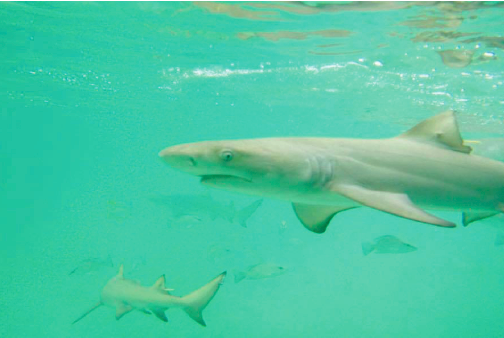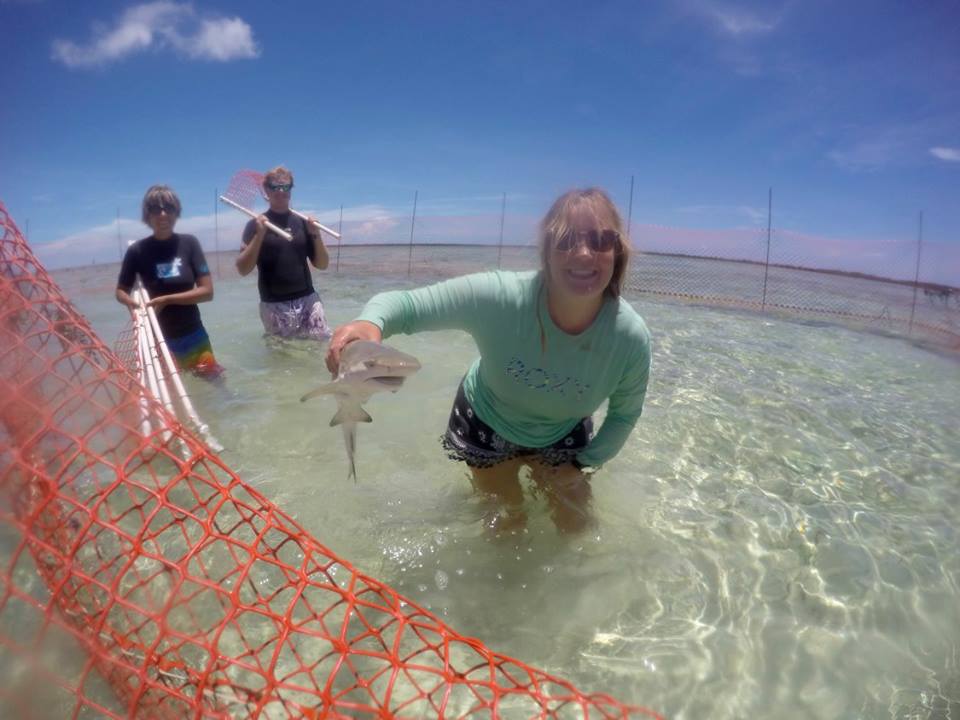Bimini Biological Field Station
Rose Boardman
There are definitely moments in life that take your breath away. I had such a moment floating in the current watching four great hammerhead sharks gracefully circling below me in the waters of Bimini. I’m sure some of you are thinking, “yeah that would take my breath away…I’d be terrified!”
The great hammerhead cruising the sandy bottoms of Bimini. Photo: Jenny Bortoluzzi @sharkjenny
Before this moment I had never seen a shark in the wild, so I was a little nervous. However, the second I entered the water those initial feelings shifted. Before I knew it I was in complete admiration. Everything was fine; in fact, it was better than fine, it was truly amazing!
So how did I end up here? Back in 2017, I was fortunate enough to undertake a placement year at the Bimini Biological Field Station (aka Shark Lab) as part of my undergraduate degree.
Bimini Biological Field Station (BBFS) is a non-profit organisation located on the Island of South Bimini, Bahamas. Dr. Gruber, a renowned scientist in shark behaviour, founded the station in 1990 through Miami University. After multiple excursions to Bimini in the 1980’s, Dr. Gruber recognized that the large shark population present made it a great place to conduct research He was later successful in gaining funding to build a full-time facility for budding shark enthusiasts and the Bimini Biological Field Station was established. With the intention of functioning as a ‘research vessel,’ the lab was built as a small wood-framed house located on the south shore of the island.”
The Lab was built with three specific aims
To improve the biological knowledge of sharks and rays through advanced fieldwork.
To conduct research to advance the field of marine science and conservation biology.
To raise public perception and awareness of sharks through community outreach.
BBFS is renowned for its ongoing research on sharks and rays, particularly the early work on the lemon shark species. At the lab, many cutting-edge research techniques are used to collect sufficient and reliable data on the sharks around Bimini. Approximately every three years the research carried out will change depending on what projects PhD students are undertaking.
Captive experiment researching the personality of lemon sharks. Photo: Rose Boardman @oceandreaming94
Throughout the months of May and June, two weeks are dedicated to the Labs annual PIT Lemon shark-tagging program. PIT is an acronym for ‘’Passive Integrated Transponder” a uniquely coded microchip, the size of a grain of rice, that is directly inserted into the shark’s body cavity under the dorsal fin. This device acts as a personal barcode for the animal (just like your pets microchip) and is read using a PIT tag reader; a number is displayed on the screen if a shark has a pit tag present. This information is recorded in the field and is then inputted into an access database for future reference. This provides the lab with a system to monitor shark growth as sharks can be recaptured multiple times a year. The program has an amazing success rate, capturing 99% of this juvenile shark population and is the longest standing survey of a single shark population globally.
Captive experiment researching the personality of lemon sharks. Photo: Rose Boardman @oceandreaming94
For the past 18 years the Shark Lab has monitored the juvenile Lemon shark populations in Bimini. Scientists assess survival, growth, and mating characteristics of the sharks in two mangrove-fringed nursery areas called North Sound and Shark Land. Once a shark is found in the gillnet (which are set for 12 hours and checked every 5 minutes) the team immediately removes it, records the time and location of capture, and radios the information to the tagging boat before transporting the shark for a more detailed ‘work up’. During the work up the sharks weight, sex and body measurements are taken. Isotope and DNA samples may also be taken from the dorsal fin.
The information recorded at this stage is crucial for past and future data comparisons, for example when the animals re-captured, they can determine how much it has grown, who their siblings are (through DNA), weight fluctuations, and movements from initial capture locations. After the12-hour cycle, the net boats haul their lines and head back to the Lab, all equipment is cleaned and the team then head off to bed for 6 to 8 hours before the crew wake up to start the whole process again.
Before this placement, I had zero experience with sharks. My first week was spent in class to ensure that I was comfortable using GPS, tying knots, and piloting small boats, along with all other Sharklab necessities (yep, that includes pest control). Among the most exciting of these classes was shark handling, where you learn how to safely handle juvenile sharks. I remember this week being one big blur spending half the time thinking there is NO way I’m going to remember all this. But before I knew it I was immersed in the everyday life of the lab and it was my new home.
Throughout the following months, I was introduced to various research techniques ranging from acoustic telemetry, longlines, baited remote underwater video surveys (BRUVs), personality trials, and shark workups, which involved tagging and taking biological information from captured sharks. Every day was different; I learnt so much and even witnessed a lemon shark GIVE BIRTH!
Safety shuffling juvenile lemon sharks for personality experiments. Photo: Rose Boardman @oceandreaming94
The research conducted at the shark lab is incredible and is helping scientists to gain a better insight into the life of these amazing animals! To this day I can only speak highly of the lab and I will forever be grateful for the amazing opportunities I had (and the amazing people I met).




